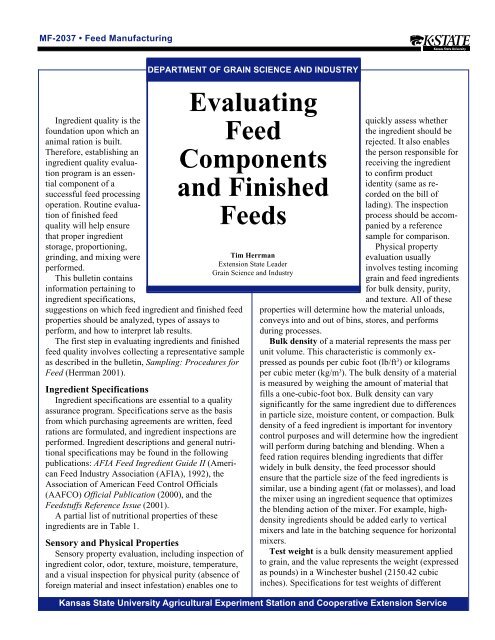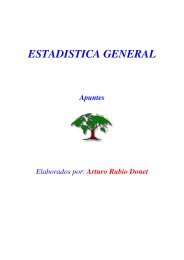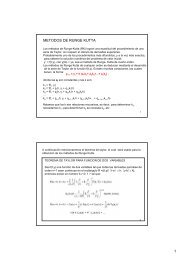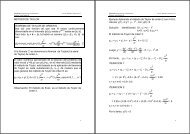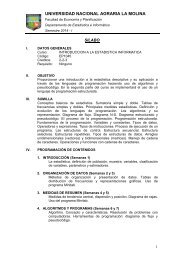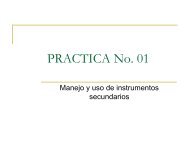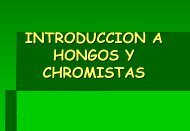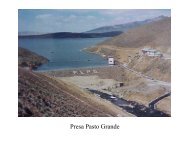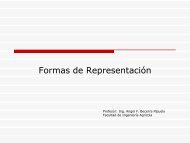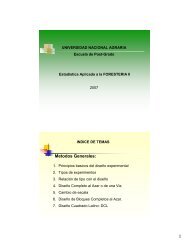MF2037 Evaluating Feed Components and Finished Feeds - K-State ...
MF2037 Evaluating Feed Components and Finished Feeds - K-State ...
MF2037 Evaluating Feed Components and Finished Feeds - K-State ...
You also want an ePaper? Increase the reach of your titles
YUMPU automatically turns print PDFs into web optimized ePapers that Google loves.
MF-2037 • <strong>Feed</strong> ManufacturingIngredient quality is thefoundation upon which ananimal ration is built.Therefore, establishing aningredient quality evaluationprogram is an essentialcomponent of asuccessful feed processingoperation. Routine evaluationof finished feedquality will help ensurethat proper ingredientstorage, proportioning,grinding, <strong>and</strong> mixing wereperformed.This bulletin containsinformation pertaining toingredient specifications,suggestions on which feed ingredient <strong>and</strong> finished feedproperties should be analyzed, types of assays toperform, <strong>and</strong> how to interpret lab results.The first step in evaluating ingredients <strong>and</strong> finishedfeed quality involves collecting a representative sampleas described in the bulletin, Sampling: Procedures for<strong>Feed</strong> (Herrman 2001).Ingredient SpecificationsIngredient specifications are essential to a qualityassurance program. Specifications serve as the basisfrom which purchasing agreements are written, feedrations are formulated, <strong>and</strong> ingredient inspections areperformed. Ingredient descriptions <strong>and</strong> general nutritionalspecifications may be found in the followingpublications: AFIA <strong>Feed</strong> Ingredient Guide II (American<strong>Feed</strong> Industry Association (AFIA), 1992), theAssociation of American <strong>Feed</strong> Control Officials(AAFCO) Official Publication (2000), <strong>and</strong> the<strong>Feed</strong>stuffs Reference Issue (2001).A partial list of nutritional properties of theseingredients are in Table 1.Sensory <strong>and</strong> Physical PropertiesSensory property evaluation, including inspection ofingredient color, odor, texture, moisture, temperature,<strong>and</strong> a visual inspection for physical purity (absence offoreign material <strong>and</strong> insect infestation) enables one toDEPARTMENT OF GRAIN SCIENCE AND INDUSTRY<strong>Evaluating</strong><strong>Feed</strong><strong>Components</strong><strong>and</strong> <strong>Finished</strong><strong>Feed</strong>sTim HerrmanExtension <strong>State</strong> LeaderGrain Science <strong>and</strong> Industryquickly assess whetherthe ingredient should berejected. It also enablesthe person responsible forreceiving the ingredientto confirm productidentity (same as recordedon the bill oflading). The inspectionprocess should be accompaniedby a referencesample for comparison.Physical propertyevaluation usuallyinvolves testing incominggrain <strong>and</strong> feed ingredientsfor bulk density, purity,<strong>and</strong> texture. All of theseproperties will determine how the material unloads,conveys into <strong>and</strong> out of bins, stores, <strong>and</strong> performsduring processes.Bulk density of a material represents the mass perunit volume. This characteristic is commonly expressedas pounds per cubic foot (lb/ft 3 ) or kilogramsper cubic meter (kg/m 3 ). The bulk density of a materialis measured by weighing the amount of material thatfills a one-cubic-foot box. Bulk density can varysignificantly for the same ingredient due to differencesin particle size, moisture content, or compaction. Bulkdensity of a feed ingredient is important for inventorycontrol purposes <strong>and</strong> will determine how the ingredientwill perform during batching <strong>and</strong> blending. When afeed ration requires blending ingredients that differwidely in bulk density, the feed processor shouldensure that the particle size of the feed ingredients issimilar, use a binding agent (fat or molasses), <strong>and</strong> loadthe mixer using an ingredient sequence that optimizesthe blending action of the mixer. For example, highdensityingredients should be added early to verticalmixers <strong>and</strong> late in the batching sequence for horizontalmixers.Test weight is a bulk density measurement appliedto grain, <strong>and</strong> the value represents the weight (expressedas pounds) in a Winchester bushel (2150.42 cubicinches). Specifications for test weights of differentKansas <strong>State</strong> University Agricultural Experiment Station <strong>and</strong> Cooperative Extension Service
2Table 1. Ingredient ProfileIngredient Protein Fat Fiber Ash Moisture Calcium Phosphorus Magnesium Pepsin Digest % BrixAlfalfaSun-cured (13%) 13.2 1.9 33.0 7.5 11.0Sun-cured (15%) 15.2 1.9 30.0 7.2 11.0Dehydrated (15%) 15.2 2.3 30.0 7.5Dehydrated (22%) 22.2 3.0 20.0 7.5Corn < 15.0Corn Gluten <strong>Feed</strong> 18.0 - 24.0 0.5 - 1.0 6.2 - 7.8 7.3 11.0Corn Gluten Meal 41.0 - 43.0 1.0 - 2.5 4.0 - 6.0 11.060.0 - 65.0 1.0 - 5.0 0.5 - 2.5 1.8 13.0Cottonseed Meal 41.0 0.9 - 3.3 9.2 - 13.4 8.0 - 10.0Fat < 1.0Feathermeal 80.0 - 85.0 2.5 1.5 3.0 10.0 0.75 75.0Limestone 98.0 38.0 1.0Methaden Fish Meal 60.0 11.0 7.0 - 11.0 92.0Meat/Bone Meal 50.4 10.4 2.4 31.5 7.0 9.0 4.1 86.0Middlings 15.5 - 17.5 3.5 - 4.5 8.0 - 9.0Molasses 9.0 9.0 23.0 79.5Rice Mill <strong>Feed</strong> 7.4 6.7 26.0 19.0 8.0 0.6 0.6Peanut Meal 1 47.0 1.0 7.0 6.0 10.0Peanut Meal & Hulls 1 45.0 2.0 15.0 6.0 10.0 - 8.0Poultry Meal 55.0 - 65.0 8.0 - 12.0 2.0 - 4.0 12.0 - 18.0 6.0 - 10.0 8.0 4.0 88.0Sorghum 8.9 2.0Soybean Meal 2w/ Hulls 44.0 1.0 7.0 6.0 12.0Dehulled 48.0 - 50.0 1.0 3.5 6.0 12.0Sunflower MealDehulled 46.1 1.6 13.1 10.0w/ Hulls 32.1 1.6 23.7 10.01Solvent extraction of oil.2Based on solvent extraction of the oil. Mechanical extraction will have 4% fat.grains <strong>and</strong> grades are presented in the bulletin GrainGrading St<strong>and</strong>ards in <strong>Feed</strong> Manufacturing (Herrman<strong>and</strong> Kuhl, 1997). The procedure for measuring testweight is included in separate bulletins listing thegrains’ name (e.g., Corn: Grading Procedures, 2000).Ingredient purity refers to the absence of contaminants.The source of these contaminants may bephysical (e.g., glass), chemical (e.g., seed treatment),<strong>and</strong> microbial (e.g., mycotoxin). The use of h<strong>and</strong> sievesto inspect for physical contaminants enables rapidevaluation of material. For example, the use of twosieves (12/64-inch round-holed sieve placed on top of a5/64-inch round hole sieve) separates dockage (nonwheatmaterial) from wheat. The material on the topsieve <strong>and</strong> the pan underneath the bottom sieve containdockage. Visual inspection is then performed on thedockage-free wheat (wheat on top of the 5/64-inchsieve) to identify non-wheat material which is referredto as foreign material. Chemical <strong>and</strong> microbial contaminantscan be performed by laboratories listed at theback of this bulletin (Tables 2 <strong>and</strong> 3). Further detailson analyses for microbial contaminants <strong>and</strong> their effecton animal performance are presented in the followingbulletins: Mycotoxins in <strong>Feed</strong> Grains <strong>and</strong> Ingredients(Trigo-Stockli <strong>and</strong> Herrman, 2000) <strong>and</strong> Quality Managementfor <strong>Feed</strong> Related Disease Prevention(Herrman <strong>and</strong> Stokka, 2001).Texture of an ingredient is measured visually <strong>and</strong>with sieves. Soybean meal texture is described visuallyas “homogeneous, free-flowing, without coarse particlesor excessive fines” (AFIA, 1992). Soybean mealtexture measured by sieve analysis is described as “95to 100 percent through U.S. St<strong>and</strong>ard Sieve No. 10; 40to 60 percent through U.S. St<strong>and</strong>ard Sieve No. 20; <strong>and</strong>a maximum 6 percent through U.S. St<strong>and</strong>ard Sieve No.80” (AFIA, 1992). For further information about sieves<strong>and</strong> particle-size analysis, refer to the bulletin titled<strong>Evaluating</strong> Particle Size (Herrman, 2001).
3Nutritional PropertiesNutritional properties of feed ingredients requirelaboratory analysis; this usually entails expensiveanalytical equipment operated by professional chemists.Many feed companies use commercial labs forthese analyses (Table 1). Most analysis techniquesinvolve the use of procedures tested <strong>and</strong> approved byscientific organizations such as the Association ofOfficial Analytical Chemists’ (AOAC, 2000) OfficialMethods of Analysis <strong>and</strong> the American Association ofCereal Chemists’ (AACC, 1995) Approved Methods ofAnalysis.MoistureMoisture content affects an ingredient’s nutritionalcontent <strong>and</strong> its performance during h<strong>and</strong>ling, storage,<strong>and</strong> processing. Both direct <strong>and</strong> indirect measures ofingredient <strong>and</strong> finished feed moisture are approved forfeed industry use. Direct methods include oven drying<strong>and</strong> distillation while indirect methods include nearinfrared (NIR) spectral analysis, conductance, <strong>and</strong>water activity.The oven drying method involves the removal offree water from a sample through heating <strong>and</strong> measurementof weight loss. This procedure is based on theprinciple that the boiling point of pure water is 212° F(100° C) at sea level. The likelihood that a compoundwill decompose or volatilize (turn from solid to vapor)determines the type of oven used (convection, forceddraft, or vacuum oven). A vacuum oven lowers theboiling point of water <strong>and</strong> allows the oven dryingprocedure to be performed at a lower temperature, thusreducing loss of dry matter through volatilization.Calculation of moisture content <strong>and</strong> total solids isperformed as follows:% Moisture (wt/wt) = wt H 2 O in sample × 100wt of wet samplewhere: wt H 2O in sample = wet wt – dry wt% Total Solids = wt of dry sample × 100wt of wet sampleIn the case of semi-moist products (e.g., dog food)the Karl Fischer method is preferred. Water is extractedwith methanol from pet food that contains othervolatile components, <strong>and</strong> an aliquot is titrated withKarl Fischer reagent. This test is good for productscontaining between 20 to 30 percent moisture (AOACOfficial Method 991.02).Moisture content in heat-sensitive feed ingredients ismeasured using the distillation method. In this technique,the ingredient is boiled in a solvent <strong>and</strong> water isdriven off from the sample, condensed, <strong>and</strong> measured(AOAC Official Method 925.04).Indirect moisture measurement for feed grainsinvolves the use of an electrical moisture meter (AACCMethod 44-11). Another indirect moisture measurementcan be performed using a beam of light in thenear infrared (NIR) frequency with a spectrophotometer.This method works well for feed grains, feedingredients, <strong>and</strong> finished feeds.ProteinProteins are comprised of amino acids which are thebuilding blocks of protein. When formulating a completefeed, the nutritionist creates a feed ration with acomplete balance of amino acids. A shortage of oneamino acid in a complete ration can cause animals toexperience depressed growth rate, poor feed conversion,<strong>and</strong> reduced reproductive performance. Mostprotein tests evaluate the nitrogen (N) content of thesample; nitrogen is present in protein molecules atabout 16 percent. The combustible nitrogen analyzerhas grown in popularity as the preferred method formeasuring N. This technique is reliable, quick, doesnot involve the use of highly corrosive acids <strong>and</strong> bases,<strong>and</strong> its cost is fairly reasonable. Additionally, the useof optical measurement of protein content using NIRtechnology works well for cereal grains, oilseeds, <strong>and</strong>finished feed.Assaying feed for individual amino acids is expensive<strong>and</strong> is seldom performed by a feed company.Thus, nutritionists use st<strong>and</strong>ard values for amino acidcontent in feed ingredients based on the NationalResearch Council publications (NRC, 2001).FatCrude fat content is measured by extracting fat withan ethyl ether solvent <strong>and</strong> then weighing the extractedfat in a vessel after the solvent has been evaporated.Crude fat is a term that refers to both fats <strong>and</strong> oils or amixture of the two <strong>and</strong> all other organic solublecompounds. The melting point of most fats is such thatthey are solid at ordinary room temperature, while oilshave lower melting points <strong>and</strong> are liquids at roomtemperatures. Fats are high-energy ingredients containingabout 2.25 times the amount of energy as othernutrients. Fat analyses should include moisture, impuri-
4ties, unsaponifiable materials (M.I.U.), <strong>and</strong> free fattyacids (FFA). FFA content should not exceed 15percent.Additionally, NIR technology works well formeasuring oil content in oilseed crops (e.g., soybeans),corn, <strong>and</strong> on complete feeds.FiberCrude fiber includes the materials that are indigestibleto humans <strong>and</strong> non-ruminant animals. It is definedas the material that is insoluble in dilute acid <strong>and</strong> dilutealkali under specified conditions. Crude fiber is used asan index of an ingredient’s feeding value since materialshigh in fiber are typically low in nutritional value.MineralsMineral analysis procedures are described in theNational <strong>Feed</strong> Ingredient Association’s (NFIA, 1991)Laboratory Methods Compendium, Volume I.Calcium constitutes about 2 percent of the bodyweight <strong>and</strong> is important for bones, teeth, <strong>and</strong> musclecontraction <strong>and</strong> relaxation, especially the heartbeat; hasa role in the transmission of nerve impulses; is necessaryfor blood clotting; <strong>and</strong> activates a number ofenzymes.Phosphorus is closely associated with calcium, thus,a deficiency or overabundance of one will interferewith the utilization of the other. Phosphorus is involvedwith bone formation <strong>and</strong> maintenance, teeth development,milk secretion, <strong>and</strong> building muscle tissue; it isan essential element in genetic material, metabolicfunctions, <strong>and</strong> osmotic <strong>and</strong> acid-base balance.Magnesium interacts with calcium <strong>and</strong> phosphorus.If extremely low, magnesium will cause calcium to bedeposited in soft tissues forming calcified lesions. Anexcess of magnesium upsets calcium <strong>and</strong> phosphorusmetabolism.Sodium helps control the osmotic pressure <strong>and</strong> acidbasebalance in body fluids (upon which depends thetransfer of nutrients to the cells <strong>and</strong> removal of wastematerial from cells). Sodium is associated with musclecontraction <strong>and</strong> nerve function.Pepsin DigestPepsin digest is a procedure used to determine theprotein digestibility of animal by-product meals.Animal by-product meal is processed under extremetemperature conditions that can cause the proteins tobecome denatured <strong>and</strong> indigestible. Results of a pepsindigest analysis are usually reported as a percentage ofpepsin indigestible residue or percent of crude proteinthat is pepsin indigestible. The AFIA <strong>Feed</strong> IngredientGuide II lists the following recommendations foranimal by-product meals:■ Poultry Feathers. Not less than 75 percent ofcrude protein should be pepsin digestible.■ Meat Meal. Not more than 14 percentindigestible residue <strong>and</strong> not more than 11percent of crude protein should be pepsinindigestible.■ Meat <strong>and</strong> Bone Meal. Not more than 14percent indigestible residue <strong>and</strong> not more than11 percent of crude protein should be pepsinindigestible.UreaseUrease is an enzyme (present in soybeans) that actson urea to produce carbon dioxide <strong>and</strong> ammonia.Urease is controlled by heating to denature the enzyme,<strong>and</strong> as such, is analyzed in soybean meal to assess if ithas been properly processed.MicroscopicAll microscopic identification is based upon relatingthe items seen to known material. Through the use oflow magnification (8 to 50 times) materials are examined<strong>and</strong> identified based on physical characteristicssuch as shape, color, particle size, softness, hardness,<strong>and</strong> texture. <strong>Feed</strong> microscopy is a useful method foridentifying impurities/contaminants <strong>and</strong> evaluating thequality of incoming ingredients. It also serves as auseful method for identifying missing ingredients infinished feed.M.I.U.M.I.U. st<strong>and</strong>s for moisture, impurities, <strong>and</strong>unsaponifiable material. Fat sources should be evaluatedfor these components <strong>and</strong> should not exceed thefollowing levels: moisture less than or equal to1 percent, impurities less than or equal to .5 percent,unsaponifiable material less than or equal to 1 percent.BrixBrix is a term commonly used to indicate the sugar(sucrose) content of molasses. This analysis is performedbased on the optical properties of the molassesusing a refractometer. Brix is expressed in degrees <strong>and</strong>is closely related to percent sucrose. The AFIA <strong>Feed</strong>Ingredient Guide II specifies a Brix reading of 79.5degrees.
5LaboratoriesWhen selecting a laboratory, price should not be theonly consideration. It is important to find out whichprofessional association laboratory personnel belong to<strong>and</strong> analytical techniques used. Official methods aretested <strong>and</strong> approved by members of these professionalorganizations: i.e., Association of Official AnalyticalChemists (AOAC) or American Association of CerealChemists (AACC).Some membership affiliations to look for include:AOAC, AACC, American Chemical Society, AmericanOil Chemists Society, National Oilseed ProcessorsAssociation, American Fats <strong>and</strong> Oils Association,National Institute of Oilseed Products, <strong>and</strong> NFIA. Alsocheck to see if the lab participates in check sampleprograms provided by the Association of American<strong>Feed</strong> Control Officials (AAFCO), American <strong>Feed</strong>Ingredients Association, <strong>and</strong> other professional organizations.Table 2 presents a partial list of labs <strong>and</strong> mailingaddress, phone number, <strong>and</strong> web address where services<strong>and</strong> prices are listed. Laboratories <strong>and</strong> servicesappearing in this publication are used for identificationonly. No endorsement is intended, nor is criticismimplied of laboratories not mentioned.Most labs will analyze for individual components aswell as offer special rates for grouped analyses. Onesuch common group analysis is proximate analysis.Proximate analysis consists of moisture, crude protein,crude fat, crude fiber, ash, <strong>and</strong> nitrogen-free extract.Analytical Variation (AV)AAFCO has established analytical variation (AV)guidelines in order to assist control officials in makingdecisions regarding marginally acceptable products(AAFCO, 2000). These variances are intended to allowfor inherit variability in sampling <strong>and</strong> laboratoryanalyses. They are not intended to allow for deficienciesor excesses in a product or poor analytical techniques.Table 3 shows the analytical variances forsome of the common ingredients. If the assay indicatesthat the ingredient is outside the analytical variance,the feed does not conform to label requirements.The concentration range indicates for what inclusionrate (level) the Analytical Variation Percentages(AV%) apply; e.g., moisture AV% applies to feedcontaining between 3 <strong>and</strong> 40 percent moisture.The AV% can be calculated using the following steps:Step 1: Multiply the expected or guaranteed value bythe value derived from the formula in Table 3 in theAV% column. Convert the AV% value to thedecimal equivalent (move the decimal two places tothe right).Step 2: Add <strong>and</strong> subtract the value obtained in Step 1to the expected or guaranteed value.Example:Suppose a sample of soybean meal was submitted forprotein analysis. If the expected or guaranteedprotein content was 44%, the acceptable rangewould be 42.9-45.1.Step 1: 44 × {(20 ÷ 44 + 2) ÷ 100} = 1.08Step 2: 44 – 1.08 = 42.944 + 1.08 = 45.1Drug AnalysisThe FDA’s Current Good Manufacturing Practices(CGMPs) stipulate that periodic assays of medicatedfeeds for drug components shall be performed as ameans of monitoring the manufacturing process. Eachcategory II Type A drug must be sampled <strong>and</strong> assayedthree times each year. For medications containing acombination of drugs, perform the assay on only onedrug each time <strong>and</strong> rotate the drugs analyzed.If the results of these assays are outside the permissiblelimits listed in Tables 4 <strong>and</strong> 5 (<strong>Feed</strong> AdditiveCompendium, 2001), an investigation <strong>and</strong> correctiveaction must be implemented. The CGMPs also stipulatethat “corrective action shall include provisions fordiscontinuing distribution where the medicated feedfails to meet the labeled drug potency. Distribution <strong>and</strong>subsequent production of the particular feed shall notbegin until it has been determined that proper controlprocedures have been established.”Many commercial feed mills <strong>and</strong> on-farm feedprocessors are not required by law to conduct drugassays since they are not registered (for further information,refer to Kansas <strong>State</strong> University Extensionbulletins MF-2042 <strong>and</strong> MF-2043 by Herrman et al.,2000). However, routine inspection of finished feed fordrug potency is a good business practice.Unfortunately, the CGMPs do not provide advice onhow to investigate high or low drug potency. Typicalsources (or reasons) for out-of-tolerance assays includethe following:• the medicated article has lost its drug potency,• incorrect weighing of the medicated article,• poor mixing of the medicated article into the feed,• poor sampling technique.
6One way to perform drug assays on medicated feedis to use the same sampling technique used to conductmixer performance tests. A complete description of thisprocedure is listed in the bulletin titled Testing MixerPerformance (Herrman <strong>and</strong> Behnke, 2001). Theprocedure involves collecting samples from 10 representativelocations in the mixer. Combine the samplesto form a single composite sample for the drug assay.One half of the composite sample should be retainedfor a minimum of three months, in the event the firstsample is out of tolerance. Also, collect <strong>and</strong> retain asample of the medicated article. If the feed is out oftolerance, submit a sample of the medicated article <strong>and</strong>the retained portion of the feed sample for drug analysis.Note: similar procedures may be followed foridentifying the source of variation of other ingredientsin complete feed.The CGMPs also specify methods to avoid crosscontaminationof feed when using medicated articles toproduce medicated feed. These methods includeflushing, sequencing, <strong>and</strong> equipment clean-out. Proceduresto avoid drug cross-contamination are discussedin detail in MF-2055.Utilizing Assay ResultsAfter investing considerable time <strong>and</strong> capital tocollect a representative sample <strong>and</strong> have it analyzed,the feed processor must manage the information.Correct information management will assist in:• detecting ingredient/product variation,• evaluating suppliers,• determining the discount for subst<strong>and</strong>ard product,• fine-tuning feed rations,• explaining animal performance problems,• meeting FDA CGMPs (if feed mill is licensed).A simple way to utilize information involves recordinglab results in table form (either by h<strong>and</strong> or on acomputer spreadsheet program). Columns in the tableshould include the date material was received, labnumber assigned to the sample, ingredient supplier,<strong>and</strong> assay results (e.g., protein, moisture). Separate datasheets should be kept for each ingredient type (e.g.,grain, protein, drug). These results should be regularlycompared with contract specifications to ensuresuppliers are shipping ingredients that meet or exceedquality criteria. Summarize data by month <strong>and</strong> supplierto detect noticeable trends.The use of Statistical Process Control (SPC) toevaluate assay data provides an additional managementtool from which to control variability in finished feed,thus improving product quality <strong>and</strong> profitability. Forfurther information, read the bulletin titled StatisticalProcess Control: Techniques for <strong>Feed</strong> Manufacturing(Herrman, 2001).Summary<strong>Feed</strong> ingredients should be routinely evaluated toensure they are safe, they contain the correct amount ofthe specified nutrient, <strong>and</strong> to ensure the finished feedquality will optimize animal performance. A list ofingredients, their important nutritional components,where they can be tested, <strong>and</strong> how to interpret thisinformation is provided in this bulletin.Permitted analytical variation (PAV) guidelines areincluded to explain how to identify deficiencies orexcesses of an ingredient in a product. If the assayindicates the ingredient is outside the PAV, the feeddoes not conform to label requirements. Techniques foridentifying the source of variation <strong>and</strong> correctiveactions are discussed.ReferencesAmerican Association of Cereal Chemists. 1995. ApprovedMethods of the AACC, 9 th ed.AAFCO. 2000. Official Publication 2000. Association ofAmerican <strong>Feed</strong> Control Officials Incorporated. Atlanta,GA.AFIA. 1992. AFIA <strong>Feed</strong> Ingredient Guide II. American<strong>Feed</strong> Industry Association. Arlington, VA.Anonymous. 1991. NFIA Laboratory Methods Compendium;Volume I Vitamins <strong>and</strong> Minerals. Arlington, VA.AOAC. 2000. Official Methods of Analysis, 17 th ed. AOACInternational. Gaithersburg, MD.<strong>Feed</strong> Additive Compendium. 2001. Miller Publishing Co.Minnetonka, MN.<strong>Feed</strong>stuffs Reference Issue. 2001. <strong>Feed</strong>stuffs. Carol Stream,IL.Harner, Joseph, Tim Herrman, John Falk, <strong>and</strong> Keith Behnke.1995. Avoiding drug carryover during feed processing<strong>and</strong> delivery. Kansas <strong>State</strong> Research <strong>and</strong> ExtensionService, MF-2055. Manhattan.Herrman, Tim. 2001. <strong>Evaluating</strong> particle size. Kansas <strong>State</strong>University Research <strong>and</strong> Extension, MF-2051. Manhattan.Herrman, Tim. 2001. Sampling: procedures for feed. Kansas<strong>State</strong> University Research <strong>and</strong> Extension, MF-2036.Manhattan.Herrman, Tim <strong>and</strong> Paul Sundburg. 2000. Medicated feedadditives for swine. Kansas <strong>State</strong> University Research<strong>and</strong> Extension, MF-2042. Manhattan.Herrman, Tim <strong>and</strong> Gerald Stokka. 2001. Medicated feedadditives for beef cattle <strong>and</strong> calves. Kansas <strong>State</strong>University Research <strong>and</strong> Extension, MF-2043. Manhattan.Herrman, Tim <strong>and</strong> Keith Behnke. 2001. Testing mixerperformance. Kansas <strong>State</strong> Research <strong>and</strong> ExtensionService, MF-1172. Manhattan.Herrman, Tim <strong>and</strong> Carl Reed. 2000. Grading Corn. Kansas<strong>State</strong> University Research <strong>and</strong> Extension. Manhattan.
7Herrman, Tim <strong>and</strong> Gary Kuhl. 1997. Grain grading st<strong>and</strong>ardsin feed manufacturing. Kansas <strong>State</strong> UniversityResearch <strong>and</strong> Extension, MF-2034. Manhattan.Herrman, Tim <strong>and</strong> Gerald Stokka. 2001. Quality managementfor feed related disease prevention. Kansas <strong>State</strong>University Research <strong>and</strong> Extension. Manhattan; InReview.Herrman, Tim. 2001. Statistical process control: techniquesfor feed manufacturing. Kansas <strong>State</strong> University Research<strong>and</strong> Extension, MF-2507. Manhattan.National Research Council. 2001. Nutrient Requirements ofDairy Cattle 7 th Edition. National Academy Press.Washington, D.C.Trigo-Stockli, Dionesia <strong>and</strong> Tim Herrman. 2000. Mycotoxinsin feed grains <strong>and</strong> ingredients. Kansas <strong>State</strong> UniversityResearch <strong>and</strong> Extension, MF-2061. Manhattan.Table 3. <strong>Feed</strong> Ingredient Analytical VariationsIngredient Method a AV% RangePROXIMATE ANALYSISMoisture 934.01 930.15 935.29 12 3 - 40%Protein 954.01 976.05 976.06 (20/X + 2) 10 - 85%984.13Lysine 975.44 20 0.5-4%Fat 920.39 954.02 932.02 10 3 - 20%Fiber 962.09 (30/X + 6) 2 - 30%Ash 942.05 (45/X + 3) 2 - 88%Pepsin Digest 971.09 13Total Sugar as Invert 925.05 12 24 - 37%NPN Protein 941.04 967.07 (80/X + 3) 7 - 60%MINERALSCalcium 927.02 (14/X + 6) .5 - 25%“ 968.08 10 10 - 25%“ 12 < 10%Phosphorus 964.06 965.17 (3/X + 8) .5 - 20%Salt 969.10 (7/X + 5) .5 - 14%“ 943.01 (15/X + 9) .5 - 14%Fluorine 975.08 40 ppmCobalt 968.08 25 .01 - .16%Iodine 934.02 935.14 925.56 40 ppmCopper 968.08 25 .03 - 1%“ 30 < .03%Magnesium 968.08 20 .01 - 15%Iron 968.08 25 .01 - 5%Manganese 968.08 30 .01 - 17%Potassium 975.03 925.01 15 .04 - 8%Zinc 968.08 20 .002 - 6%Selenium 969.06 25 ppmSodium a.a. 20 .2 - 4%ICP 15 .2 - 4%VITAMINSVitamin A 974.29 30 1200 - 218,000IU/lbVitamin B 12952.20 45Riboflavin 970.65 940.33 30 1 - 1500 mg/lbNiacin 961.14 944.13 25 3 - 500 mg/lbPantothenic Acid 945.74 25 4 - 190 mg/lbaMethod References are from 17th Edition, AOAC Official Methods of Analysis.Table 2. LaboratoriesPerforming <strong>Feed</strong> Ingredient<strong>and</strong> <strong>Finished</strong> <strong>Feed</strong> AnalysesMidwest Laboratories, Inc.13611 B StreetOmaha, NE 68144-3693(402) 334-7770www.midwestlabs.comAT LaboratoryP.O. Box 752027Memphis, TN 38175(901) 363-2354SDK Laboratories, Inc.1000 Cory Rd.Hutchinson, KS 67501(620) 665-5661www.sdklabs.comCII Laboratory Inc.10835 Ambassador DriveKansas City, MO 64153(816) 891-7337www.ciisvc@ciilab.comServi-Tech1816 East Wyatt EarpP.O Box 1397Dodge City, KS 67801(620) 227-7123(800) 468-5411www.servi-techinc.comServi-Tech1602 Park West DriveP.O. Box 169Hastings, NE 68902(402) 463-3522www.servi-techinc.comDoty Laboratories2100 L <strong>and</strong> A RoadMetaria, LA 70001(504) 833-9119(877) 493-3349Barrow-Agee Laboratories1555 Three PlaceMemphis, TN 38116(901) 332-1590www.balabs@aol.comWoodson-Tenent Laboratories313 East HelenaDayton, OH 45404(937) 222-4179www.wtlabs.comWoodson-Tenent Laboratories3507 DelawareDes Moines, IA 50313(515) 265-1461www.wtlabs.comRalston Analytical Laboratories824 Gratiot Dr.St. Louis, MO 631021-800-423-68321-314-982-1310www.purina.comA&L Analytical Lab, Inc.411 N. 3rd St.Memphis, TN 38105(800) 264-4522(901) 527-2780www.al-labs.comColorado Analytical LaboratoryP.O. Box Drawer 507Brighton, CO 80601(303) 659-2313Iowa Testing LabHighway17 NorthP.O. Box 188Eagle Grove, IA 50533(515) 448-4741www.iowatestinglabs.comLivestock Nutrition LaboratoryServicesP.O. Box 1655Columbia, MO 65205(573) 445-4476Romer1301 Style Master Dr.Union, MO 63084-1156(636) 583-8600(636) 583-6553 FAXwww.romerlabs.com
8Table 4. Category IAssay LimitsAssay Limits(Percent of Labeled Amount)Drug Type A Percent 1 Type B/C 2Aklomide 90 - 110 86- 120Amprolium with ethopabate 94 - 114 80 - 120Bacitracin methylene disalicylate 85 - 115 70 - 130Bacitracinzinc 84 - 115 70 - 130Bambermycins 90 - 110 80 - 120 / 70 - 130Buquinolate 90 - 110 80 - 120Chlortetracycline 85 - 115 80 - 115 / 70 - 130Coumaphos 95 - 115 80 - 120Decoquinate 90 - 105 80 - 120Dichlorvos 100 - 115 90 - 120 / 80 – 130Diclazuril 90-110 75-120Erthromycin (thiocyanate salt) 85 - 115 < 20 g/ton 70 - 115 / 50 - 150> 20 g ton 75 - 125Iodinated casein 85 - 115 75 - 125Laidlomycin propionate 90 - 110 90 - 115 / 85 - 115Lasalocid 95 - 115 Type B (Cattle & Sheep):80 - 120;Type C (All): 75 - 125Lincomycin 90 - 115 80 - 130Melengestrol acetate 90 - 110 70 - 20Monensin 85 - 115 Chickens: 75 - 125;Cattle: 510 g/ton 80 - 120;Cattle: 10-30 g/ton 85-115;Goats: 20 g/ton 85 - 115;Liq. feed: 80 - 120Narasin 90 - 110 85 - 115 or 75 - 125Nequinate 95 - 112 80 - 120Niclosamide 85 - 20 80 - 120Nystatin 85 - 125 75 - 125Ole<strong>and</strong>omycin 85 - 120 < 11.25 g/ton 70 - 130> 11.25 g/ton 75 - 125Oxytetracycline 90 - 120 75 - 125 or 65 - 135Penicillin 80 - 120 65 - 135Poloxalene 90 - 115 Liq. <strong>Feed</strong>: 85 - 115Salinomycin 95 - 115 80 – 120Semduramicin 90-115 80-110Tiamulin 90 -115 90 - 115 or 70 - 130Tylosin 80 - 120 75 - 125Virginiamycin 85 - 115 70 - 130Zoalene 98 - 104 85 - 1151Percent of labeled amount.2Values given represent ranges for either Type B or Type C medicated feeds. For those drugs that have two range limits, the first set is for a Type B medicated feed <strong>and</strong> the secondset is for a Type C medicated feed. These values (ranges) have been assigned in order to provide for the possibility of dilution of a Type B medicated feed with lower assay limits tomake a Type C medicated feed.
9Table 5. Category IIAssay LimitsAssay Limits(Percent of Labeled Amount)Drug Type A Percent 1 Type B/C 2Amprolium 94 - 114 80 - 120Apramycin 88 - 112 80 – 120Arsanilate sodium 90-110 85-115 / 75-125Arsanilic acid 90 - 110 85 - 115 / 75 - 125Carbadox 90 - 110 75 - 125Clopidol 94 - 106 90 - 115 / 80 - 120Famphur 100 - 110 90 - 115 / 80 - 120Fenbendazole 93 - 113 75 - 125Halofuginone hydrobromide 90 - 115 75 - 125Hygromycin B 90 - 110 75 - 125Ivermectin 95 - 105 80 - 110Levamisole 85 - 120 85 - 125Maduramicin ammonium 90 - 110 80 - 120Morantel tartrate 90 - 110 85 - 115Neomycin 80 - 120 70 - 125Neomycin 80 - 120 70 - 125Oxytetracycline 80 - 120 65 - 135Nicarbazin (P) 3 98 - 106 85 - 115 / 80 - 120Nicarbazin (G) 3 90 - 110 85 - 115 / 75 - 125Narasin 90 - 110 85 - 115 / 75 - 125Nitarsone 90 - 110 85 - 120Nitromide 90 - 110 80 - 120Sulfanitran 85 - 115 75 - 125Nitromide 90 - 110 85 - 115Sulfanitran 85 - 115 75 - 125Novobiocin 85 - 115 80 - 120Pyrantel tartrate 90 - 110 80 - 120Robenidine 95 - 115 80 - 120Ronnel 85 - 115 80 - 120Roxarsone 90 - 110 85 - 120Roxarsone 90 - 110 85 - 120Aklomide 90 - 110 85 - 120Roxarsone 90 - 110 85 - 120Clopidol 94 - 106 80 - 120Bacitracin methylene disalicylate 85 - 115 70 - 130Roxarsone 90 - 110 85 - 120Monensin 90 - 110 75 - 125Sulfadimethoxine 95 - 110 85 - 115 / 75 - 125Ormetoprim (5:3) 95 - 110 85 – 115Ormetoprim (5:1) 95 - 110 85 - 115Sulfaethoxypyridazine 95 - 105 85 - 115Sulfamerazine 85 - 115 85 - 115Sulfamethazine 85 - 115 80 - 120Chlortetracycline 85 - 115 85 - 125 or 70 - 130Penicillin 85 - 115 85 - 125 or 70 - 130Sulfamethazine 85 - 115 80 - 120Chlortetracycline 85 - 115 85 - 125 or 70 - 130Sulfamethazine 85 - 115 80 - 120Tylosin 80 - 120 75 - 125Sulfanitran 85 - 115 75 - 125Aklomide 90 - 110 85 - 120Sulfanitran 85 - 115 75 - 125Aklomide 90 - 110 85 - 120Roxarsone 90 - 110 85 - 120Sulfanitran 85 - 115 75 - 125Aklomide 90 - 110 85 - 120Roxarsone 90 - 110 85 - 120Sulfaquinoxaline 98 - 106 85 - 115Sulfathiazole 85 - 115 80 - 120Chlortetracycline 85 - 125 70 - 130Penicillin 80 - 120 70 – 130Tilmicosin 90-110 85-115Thiabendazole 94-106 >2/3 7% 85-11594 - 106
10Notes
11Notes
12Br<strong>and</strong> names appearing in this publication are for product identification purposes only. No endorsement is intended,nor is criticism implied of similar products not mentioned.Publications from Kansas <strong>State</strong> University are available on the World Wide Web at: http://www.oznet.ksu.eduContents of this publication may be freely reproduced for educational purposes. All other rights reserved. In each case, credit Tim Herrman,<strong>Evaluating</strong> <strong>Feed</strong> <strong>Components</strong> <strong>and</strong> <strong>Finished</strong> <strong>Feed</strong>s, Kansas <strong>State</strong> University, August 2001.Kansas <strong>State</strong> University Agricultural Experiment Station <strong>and</strong> Cooperative Extension ServiceMF-2037 August 2001It is the policy of Kansas <strong>State</strong> University Agricultural Experiment Station <strong>and</strong> Cooperative Extension Service that all persons shall have equal opportunity <strong>and</strong>access to its educational programs, services, activities, <strong>and</strong> materials without regard to race, color, religion, national origin, sex, age or disability. Kansas <strong>State</strong>University is an equal opportunity organization. Issued in furtherance of Cooperative Extension Work, Acts of May 8 <strong>and</strong> June 30, 1914, as amended. Kansas<strong>State</strong> University, County Extension Councils, Extension Districts, <strong>and</strong> United <strong>State</strong>s Department of Agriculture Cooperating, Marc A. Johnson, Director.


